Ultra-fast Lenses

The article is over 5 years old. The information in it may be outdated.
![]()
We are working on its update. In the meantime, you can read some more recent articles.
They’re heavy and they have no zoom, but because of their image quality, some professionals use only these lenses. Why are ultra-fast lenses so highly valued?
Most photographers start with a camera fitted with a cheap universal lens. If they own a body that supports exchangeable lenses, they eventually start looking at other lenses and asking if they bring any extra benefits.
For normal DSLRs with a small APS-C sensor like the Nikon Dxx00 series and the Canon x00D and xx00D series, the most common lens is an 18-55/3.5-5.6. For mirrorless cameras like the Micro Four Thirds, it is the similar 14-42/3.5-5.6.
These basic lenses all share slow lens speeds—in other words, high lowest-available F-numbers. The designations above already tell a lot: they mean a weak F3.5 minimum for the wide end and F5.6 for the long end. But what’s wrong with a slow lens, anyway?
Problems With Slow Lenses
The first problem is of course that these lenses don’t let much light through to the sensor. In dark conditions it has to fight this by raising ISO, which causes a significant increase in noise. In these conditions you’ll have a dark viewfinder as well, and also the focusing sensors can end up confused.
Another “problem” (or trait, at least) of slow lenses is large depth of focus. Even if you focus on the main subject perfectly, the background is only halfway blurred, and so it can still be distracting. Sometimes this lack of blurring is an advantage, for example in landscape photography. But for portraits, for example, you want to suppress the background and let the person shine through.

Canon 350D, Canon EF-S 18-55/3.5-5.6, 1/250 s, F5.6, ISO 200, 55 mm focus
Depth of Field in Detail
Depth of field depends on not just the aperture you use, but also to a large degree on your sensor size. The larger the sensor, the smaller the depth of field at the same aperture. “Full-frame” sensors (also called FF or 35mm format sensors), which have the same size as a classical film frame, do very well here—they readily optically separate the photographed object from the background, which they leave highly blurred. Meanwhile the tiny sensors in phones have an enormous depth of field, making it very difficult to blur a background.
What’s So Great About Small Depth of Field?
For e.g. portraits, small depth of field is useful for “pinning” the subject and suppressing (blurring) the background. Similarly, if you’re photographing people or details against a complex indoor scene with lots of different elements in the background, minimizing the depth of field helps you to practically eliminate these distractions.
In landscape photography on the other hand you generally want practically everything to be in focus, so you want the largest depth of field available.
In order to compare the various systems, we need to take into account their “crop factor,” that is, how much smaller than full frame their sensor is. For the Canon and Nikon APS-C sensors, that comes out to 1.6 and 1.5. Micro Four Thirds has a smaller chip with a crop factor of 2. For the rest of this article, I’ll be including the crop factor for 35 mm format (FF) alongside the numbers I give.
An 18-55/3.5-5.6 lens for a Canon APS-C corresponds to a 29-88/5.7-9 lens on a full-frame.
A14-42/3.5-5.6 lens on a Micro Four Thirds corresponds to a 28-84/7.1-11 on a full-frame.
For conversion purposes I used the excellent calculator located here.
A side note: Small depths of focus can also be achieved via high zoom. For example with a 200 mm focus on any sensor, you can practically count on significant background blurring… although this is at the price of a major change of perspective, and so it’s not a universal solution.
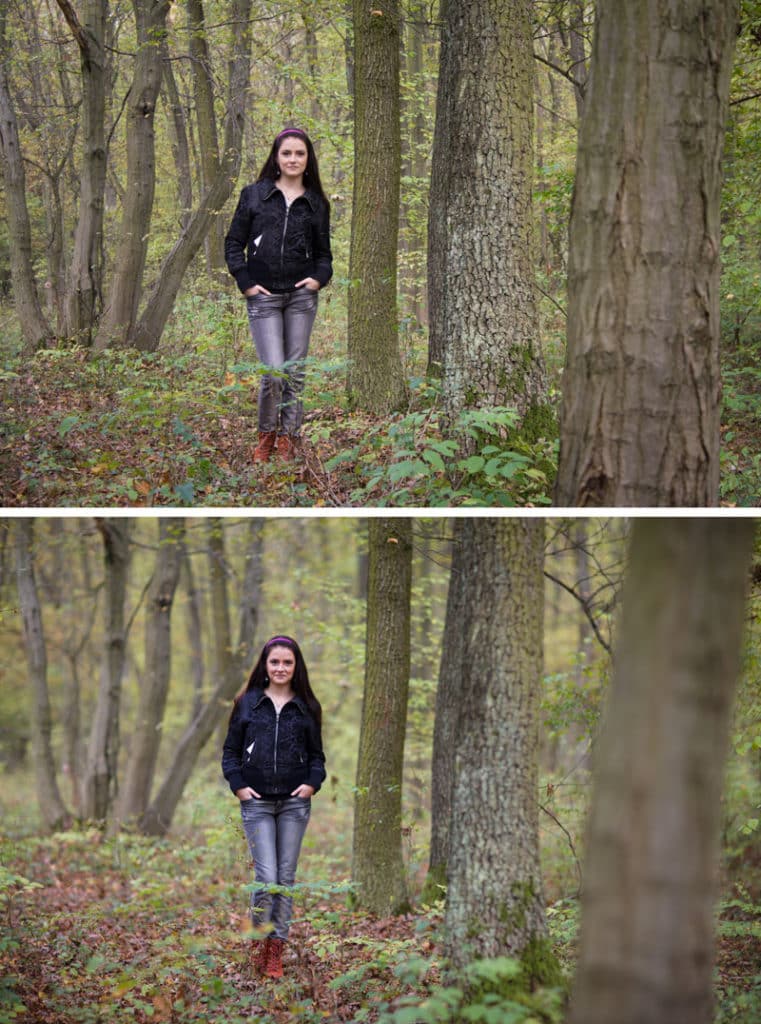
Top: Canon 350D (crop factor 1.6), Canon EF-S 18-55/3.5-5.6, 1/80 s, F5.6, ISO 400, focus 55 mm;
Bottom: Canon 5D Mark III (Full frame), Canon 85/1.8, 1/200 s, F1.4, ISO 100, focus 85 mm
The Fast Options
There are two roads to small depth of field:
- a bigger camera with a bigger sensor (and generally new lenses too, since your current lenses will usually only cover your current, smaller sensor, and would leave black corners on a larger sensor)
- “just” getting a faster lens.
You can for example fully replace your basic zoom lens with e.g. a Canon APS-C lens that’s 17-55/2.8 (FF equivalent: 27-88/4.5), or a Micro Four Thirds lens that’s 14-40/2.8 (FF: 28-80/5.7). Unfortunately they’re both several times more expensive the basic lens mentioned above, and also, even though their depth of field is significantly reduced, it’s still more than you might want.
Ultra-fast Lenses
Lenses with minimum F-numbers of F2.0 or lower are very popular among photographers. Of course, this is usually something-for-something, costing you the option of zoom—these are very often (although not always) “fixed” lenses with just one focal length.
For both Canon and Nikon, this is the beloved 50/1.8 lens (usable even on FF! On an APS-C, it creates an image like an 80/2.9 lens would on an FF). This lens is very cheap while still giving good image quality. Although it can’t fully replace the basic lens, it’s a great accessory for portraiture and similar photography.
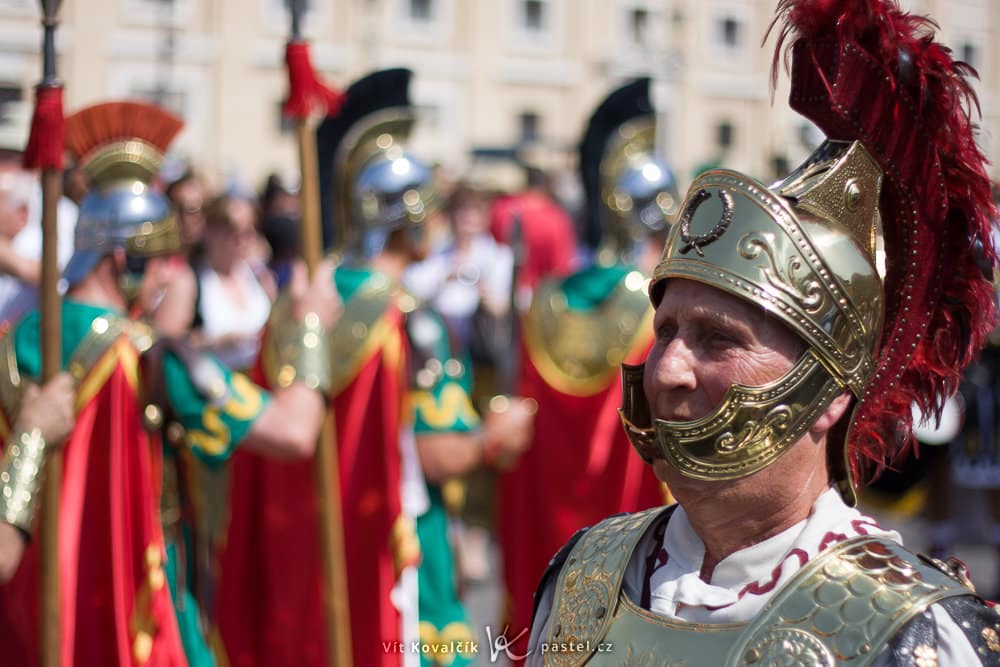
Canon 40D, Canon EF 50/1.8, 1/5000 s, F1.8, ISO 100, focus 50 mm
There are also expensive, but very good wider or narrower variants like the Canon 85/1.8 (usable on FF or APS-C; for the latter it’s the equivalent of an FF 136/2.9) or the Sigma 30/1.4 DC (FF: 48/2.3). There are also many options at other focal lengths as well; there are options for everyone.
Potential Focusing Problems
The smaller the depth of focus, the larger the demands on precision equipment and precision work.
Before you use a lens the first time, you need to make sure that it focuses properly with your camera. Tests in real-world conditions can actually be misleading, so if anything seems off to you, we recommend printing and trying a testing pattern (e.g. the one here you’ll find one with a very detailed description).
Minor imprecisions in focus can be fine-tuned away in some cameras’ menus (“Autofocus Microadjustment”). For bigger problems, you’ll need to go to a shop.
But equipment is just the first hurdle. It’s also important to adapt your technique.
You have to be much more careful when focusing, and pay attention to, for example, any tree branches around a model’s head. The focusing system might give preference to those over the actual model, and what’s more, this kind of problem isn’t visible in a tiny viewfinder, but rather, only after the full photo is created.
You also shouldn’t move too much after focusing, and if you are photographing people, they shouldn’t move too much either. In extreme cases (close-ups), you can even have one eye in focus and the other one blurred—every little movement can lead to an unusable shot!
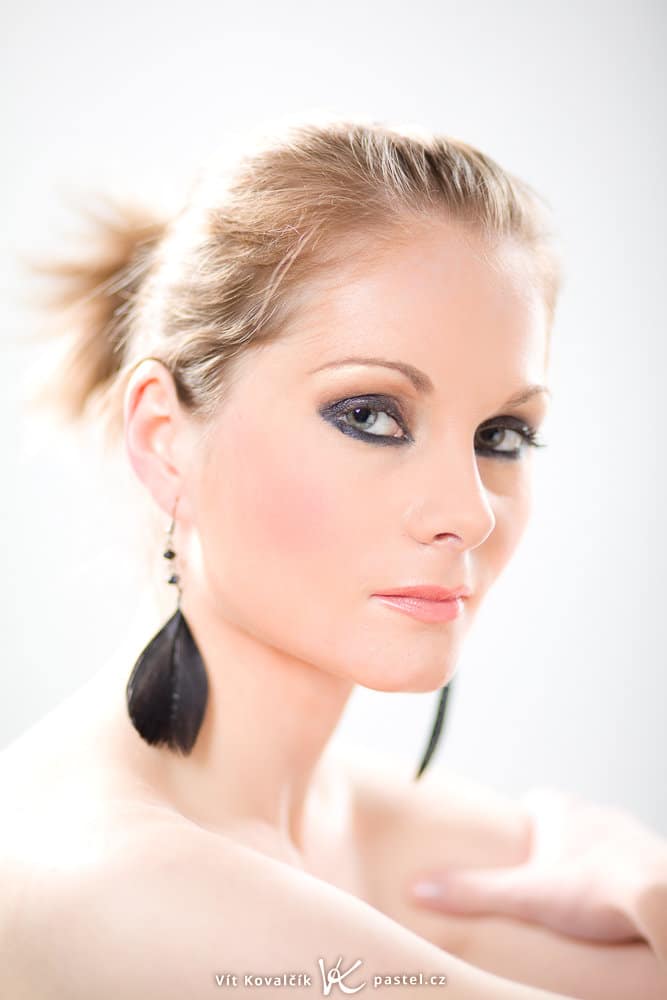
Canon 5D Mark II, Canon EF 85/1.8, 1/160 s, F1.8, ISO 100, focus 85 mm
In some situations you can also run into trouble with applying the popular “focus-recompose” technique, where you focus with the center focus point and then rotate the camera to fine-tune composition and get the subject onto a golden ratio point. For wide scenes with very small depth of field, this motion can sometimes take the subject out of focus.

These all are reasons why it’s important to get used to more frequently checking pictures right after they’re taken.
Running Into Limits
Taking pictures with a small depth of focus can also impress outdoors on a sunny day. But with a small F-number, you are forced to use very short times, and some cameras do not allow these. That mainly applies for the cheaper DSLRs. The current Canon 700D has a limit of 1/4000 seconds, and its lowest ISO is 100. For a lens with a speed of F1.4, this setting will not work under sharp sunlight, and to avoid major blowout, you will need to raise the F-number to F2 or even higher. The alternative is to use an ND filter or polarizing filter.
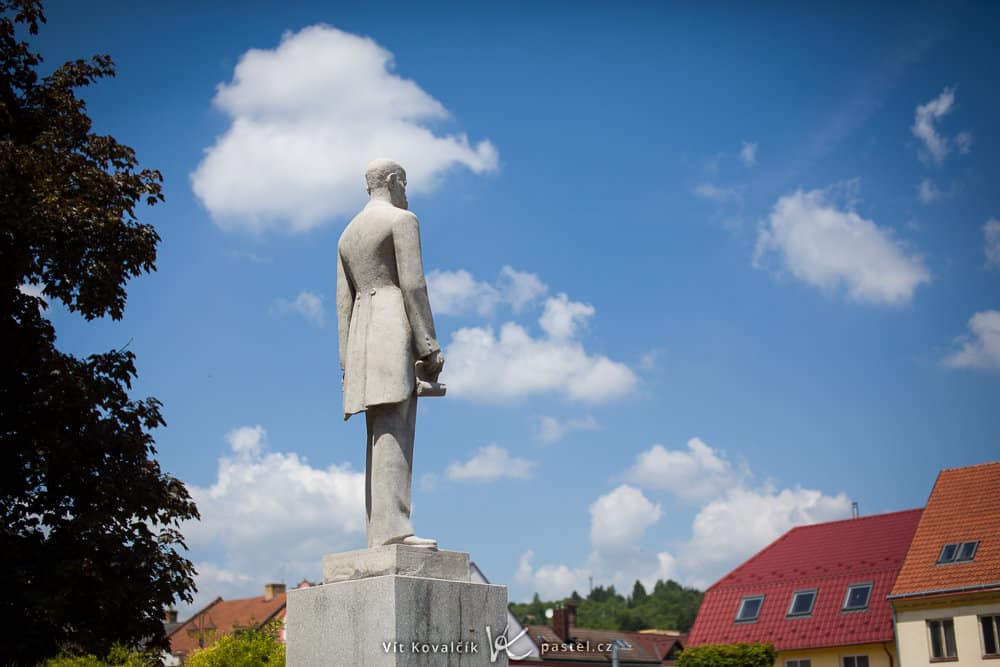
Canon 5D Mark III, Sigma 50/1.4 DG, 1/8000 s, F2.2, ISO 100, focus 50 mm
Typical Lens Defects
To produce an ultra-fast lens, manufacturers have to make compromises. This leads to two minor design problems typical for most of these products: vignetting, and “bokeh fringing.”
Vignetting, i.e. darkening of a picture’s corners, is most prevalent at the lowest F-number, and disappears with higher numbers. In some cases vignetting is unwelcome, but in others it can be welcome, because it emphasizes the subject in the middle and suppresses potentially distracting elements at the edges.
Bokeh fringing, or more technically longitudinal chromatic aberration, turns objects’ edges (fringes) purple when they’re in front of the area in focus, and turns edges green beyond the area in focus. The cause is differing light refraction for different wavelengths. This effect is visible on high-contrast contours, mainly between white and a dark color. This too disappears as F-numbers rise.

Canon 40D, Canon EF 85/1.8, 1/640 s, F1.8, ISO 100, focus 85 mm
Some lenses have a very specific problem where the focus shifts right when the aperture rises, usually when focusing to a short distance. Here the problem is in the lens’s construction, and thus cannot be solved. Because of that you have to think over how much you care about this. For an interactive example, see the last picture on the page here.
Full Frame
If we ignore the cameras that are mid-format and larger, the smallest depths of field available are offered by full-frame cameras with corresponding lenses. Even in the analog days, the “fixed 50” lens was popular (in part because zooms are hard to manufacture and therefore were introduced later); for example, the French photojournalist Henri Cartier-Bresson most often used a Zeiss Sonar 50/1.5. This focal length is still popular, along with lengths around 30 or 35 mm, and so you’ll often see them on for example the cameras used by wedding photographers.
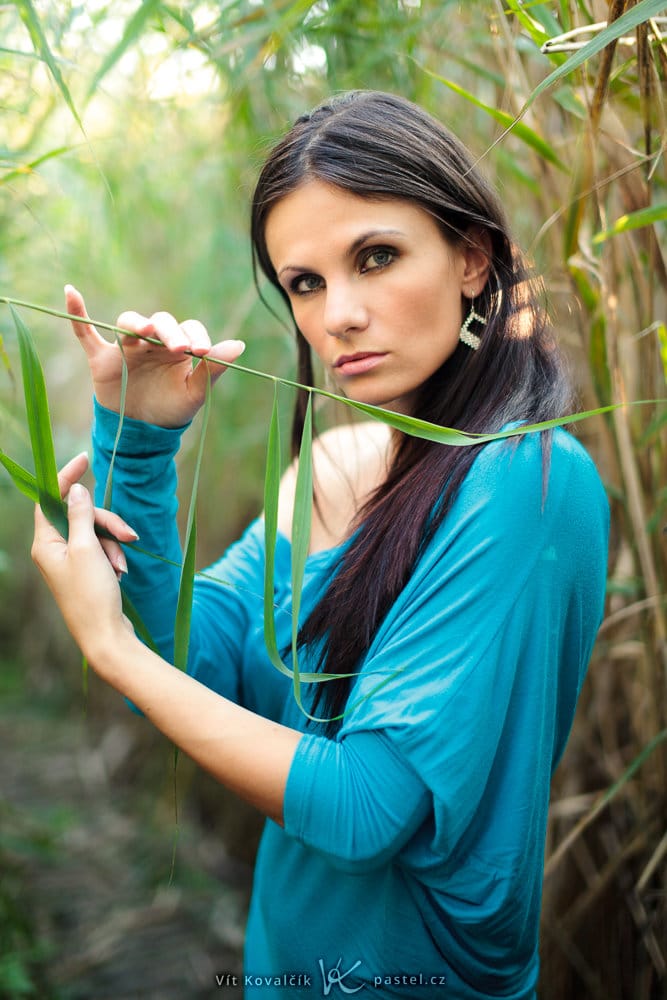
Canon 5D Mark II, Sigma 50/1.4 DG, 1/40 s, F1.4, ISO 125, focus 50 m
The preference out there for fast lenses is also visible in other articles here on Zonerama Magazine: Majo Elias generally uses a Nikon D800 and a Sigma 35/1.4 Art lens, while my favorite combination is the Canon 5D Mark III and a Sigma 50/1.4 Art (all full frame).
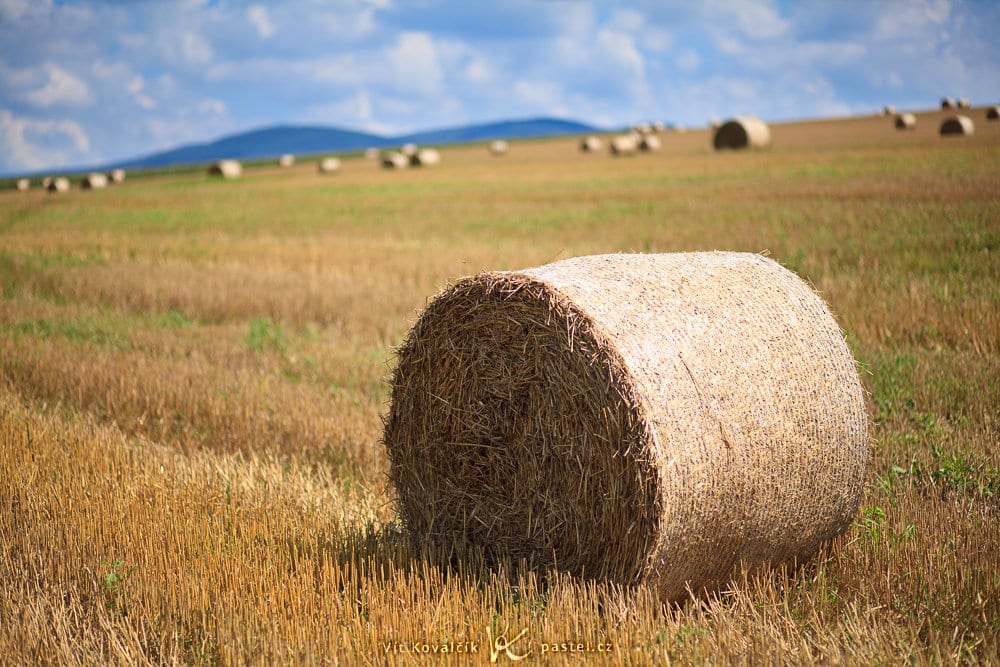
Canon 5D Mark II, Canon 85/1.8, 1/6400 s, F1.8, ISO 100, focus 85 mm
Your Options Are Expanding
Recently Sigma introduced an unusual lens that runs 18-35/1.8 and is made for APS-C sensors (FF roughly 27-52/2.7). This means that the smaller sensors now have access to a very fast zoom lens, even though it’s still only on the way to the typical full frame 24-70/2.8. Unfortunately fast zooms are heavy and expensive, but thanks to them, there is a flood of nice fixed lenses. If you haven’t done so yet, try checking out the ones available for your camera. You may be in for a pleasant surprise!

TerryB
Vit, a very interesting read but may I correct an error of fact. As regards depth of field sensor size is NOT a determinant in calculating depth of field. DoF is an optical characteristic and is the product solely of focal length, aperture and the focused distance to which the lens is set. If one wishes to be really accurate one may introduce circle of confusion as the fourth factor, but no where will you see any mention of sensor size as being a determinant. As such, DoF is completely independent of the sensor size and thus the same focal length lens set to the same aperture and focus point will exhibit identical DoF irrespective of whether it is attached to an m4/3, APS-C or FF camera.
You are not alone in propagating this myth. The number of times I’ve seen this printed in photography magazines beggars belief. It seems to be a child if the digital age.
The sensor size DoF argument is poorly stated as it misses out a very important point and which is that for the SAME FIELD OF VIEW the smaller the sensor the shorter will be the focal length of the lens needed and it is this that leads to greater depth of field.
Vit Kovalcik
All right, I know what you mean, but in my opinion it is not a myth vs reality, but simply different points of view used when doing the comparison.
From your point of view, yes, we can fix focal length and aperture (i.e. same lens) and attach different sensors to it – and you are right, we will have the same depth of field, however the field of view will be different, so in fact we will get different photo.
From my point of view, I want to get identical photo with different sensors, which means different focal lengths have to be used and to get visually same depth of field, different apertures needs to be used too.
These are of course things you have stated in your post, but I wanted to emphasize not the issues with DOF/sensor size, but the different points of view.
Harry Reid
All very informative and helpful.
Mark
Very helpful post! I have been using the Sigma 18-35 f/1.8 for about 6 months (with a Canon 70D) and LOVE it! It’s large and heavy, but the image quality is outstanding. And nothing beats having such a wide aperture on a crop camera. This is the lens that stays on my camera 90% of the time.
Now, if I could just talk my wife into letting me consider a full-frame camera… :-)
Arek
Canon 5D Mark III (Full frame), Canon 85/1.8, 1/200 s, F1.4, ISO 100, focus 85 mm …. F1.4 on F1.8 lens?
Vit Kovalcik
Oops, thanks. This was corrected in the Czech version of the article long time ago, but somehow find its way again to this version. It should be fixed now.
Bohdan Dudys
Ahoj, trošku off-topic, ale chtěl bych se zeptat, jaká je adresa na český Magazin Zonerama. Děkuji, Bohdan
Vit Kovalcik
Protějšek je http://www.milujemefotografii.cz/ , i když mám za to, že se prolínají jen některé články. Jiné jsou jen tady nebo jen tam. Tenhle je zrovna na obou, česká verze je pod tímhle odkazem:
http://www.milujemefotografii.cz/vysoce-svetelne-objektivy
M Flynn
Its great to be able to pickup all this information from years of practise by others, a great learning curve
indeed, thanks ……………………..